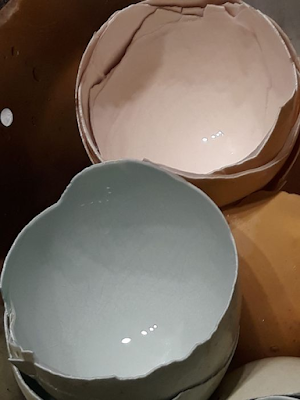Slipping out the door, I always seem to walk more quietly when heading to the chicken house. There’s always a gathering of colorful eggs from my assortment of chickens, even here in winter. Some small, some average, and often a really large egg that sometimes contains two yolks. I relish the simple life here on my farm. It is where I gather in the quiet, escaping public chaos to appreciate days paced by Mother Nature for living slowly.
Of note, this evening’s purple egg was quite the surprise. It was my first. Purple eggs really don’t exist, but rather are the result of the bloom, a protective outer coating of the egg. Blooms can color an egg purple or pink, and they wash right off in warm water.
Chickens that lay olive-colored eggs seem to be a recent favorite of those raising chickens. A few months back, I discovered I had such a chicken, and I was ever grateful for the growing variety of egg colors in my small flock. Daily, a beautiful dose of light blue eggs and cream-colored eggs fill the chicken nesting boxes, accompanying the brown and olive eggs.
The inside of a brown egg is white, but the inside of a blue egg is blue:
When I shared this with Moristotle, he reminisced:
In the background, I could hear light foot stomping, improvised guitars, voices, their music and songs. Standing there in my own silence and listening, I thought to myself, There is no way in the world that chickens didn’t have an influence on the blues.
Mississippi John Hurt. His musical genius was captured by the Library of Congress:
When I shared this with Moristotle, he reminisced:
Bettina, I don’t think I’ve told you this: I grew up on a chicken ranch, and my mother and I gathered eggs together many, many times during the years 1948-1954, when I was in 1st grade through 7th, in Petaluma, California, known locally as “The Egg Basket of the World.” I have many cherished memories from that time, among which are those of the chickens.Early one evening, after the chickens had gone to bed, when all was quiet, I entered the chicken house and was immediately transported to the Deep South, maybe Mississippi or near there, and to a historical time there aligned with early American folk blues, maybe 1920s to ’40s, give or take, a time and place steeped in poverty, hard manual labor, and hard times. My chickens were carrying on in song, a continuous harmonious wail reminiscent of a deep sultry Southern chorus of blues. Something a friend once said came to me: “Chickens sing many different songs.”
In the background, I could hear light foot stomping, improvised guitars, voices, their music and songs. Standing there in my own silence and listening, I thought to myself, There is no way in the world that chickens didn’t have an influence on the blues.
Mississippi John Hurt. His musical genius was captured by the Library of Congress:
I remained quiet and listened for a few more minutes, and then I gathered the eggs and shut the door to the chicken house, as if accidentally witnessing a secret, unknown world. I walked quickly home, remembering....
Memphis Minnie. Queen of the Country Blues, Memphis Music Hall of Fame:
Frank Stokes. Father of the Memphis Blues Guitar Style, Memphis Music Hall of Fame:
Sweet Papa Stovepipe, Reverend Thomas McKinley Peebles, Legendary Tidewater Blues and Gospel singer [New York Times article]:
Willie Dixon, who has been called “the poet laureate of the blues” and “the father of modern Chicago Blues”:
The Hillbillies, Appalachian Blues musicians:
Charley Patton, early American blues singer:
A few days later, I gathered my most pink egg, a small, delicate view of the intricacies that variation can bring about in color and song:
Memphis Minnie. Queen of the Country Blues, Memphis Music Hall of Fame:
Frank Stokes. Father of the Memphis Blues Guitar Style, Memphis Music Hall of Fame:
Sweet Papa Stovepipe, Reverend Thomas McKinley Peebles, Legendary Tidewater Blues and Gospel singer [New York Times article]:
Willie Dixon, who has been called “the poet laureate of the blues” and “the father of modern Chicago Blues”:
The Hillbillies, Appalachian Blues musicians:
Charley Patton, early American blues singer:
A few days later, I gathered my most pink egg, a small, delicate view of the intricacies that variation can bring about in color and song:
| Copyright © 2023 by Bettina Sperry |








Bettina, I am deeply apologetic about failing to comment on this post before now. As I have told a few others whom I have also neglected, it has been busy, busy in the central office (besides turning 80). What a concept, to relate chickens singing with Southern human blues singing. Thank you, thank you, for seeing the connection, researching it, writing it, molding it.
ReplyDeleteAnd the photos! My mother and I never found any colored eggs like the ones you show, although I sort of remember finding an "odd" one every now and then. The eggs we gathered were almost 100% fully white eggs. I wish my mother (or my father – no, and my father) were still alive to share their memories. (One of my dad's tasks, as an employee of the ranch owner, was to deliver truckloads of eggs to distributors in Petaluma.)